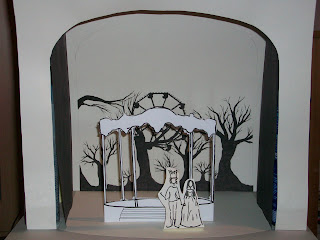




These images are my 1:25 sketch model with 1:25 scale people, roughly 5ft 5'' and 5ft 11''. They contain a kind of band stand where Ashputtel and the Prince dance, some have the helter skelter in. I think the helter skelter would have to be a flat. I have removed the two front stalls from my original sketch, as there isn't a lot of room.
I think this design looked good on paper, but it doesn't work well on the model. I think the weakest aspect is the backdrop, as most of it is hidden, and there is a huge gap at the top. Also I dont like the trees, they don't look very strong, so I am going to refer back to Arthur Rackham's work to improve the backdrop.
























